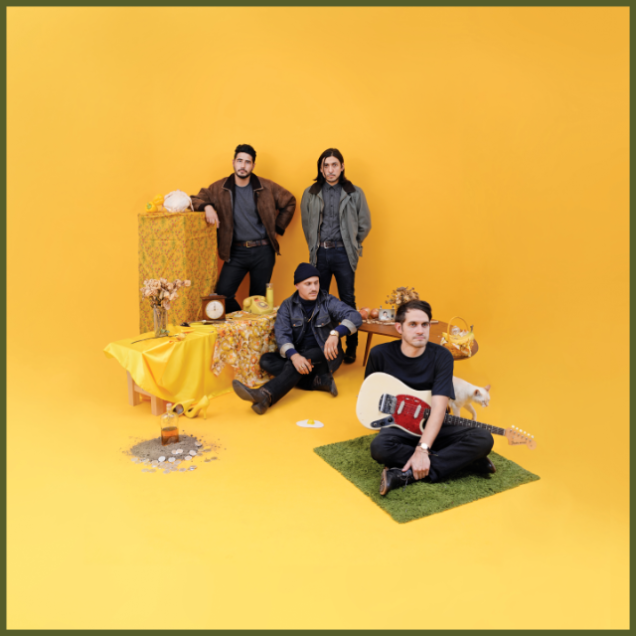REVIEW: Together Pangea @ Sonia 10/01

Once too intoxicated to regularly finish sets, LA garage punks Together Pangea cleaned up their act and sound for their current US tour. The band made a stop at Cambridge’s Sonia while promoting their third full-length album, Bulls and Roosters. The album may sound awkward and chronologically out of place in Together Pangea’s near decade-long sonic evolution due to its noticeably less-punk production, but the music finds a fitting home onstage where the lack of studio production actually works in their favor.
At not even six months old, Sonia is as new as could be; the hardwood floors are unscratched, the (bar-less) room smells of fresh drywall, and the white walls are, well, still white—a little too pristine for the likes of Together Pangea. Intuition (and a quick listen through the band’s raucous hits like “Too Drunk to Cum” and “Sick Shit”) would suggest that their sloppy, crude punk tunes are better suited for the Middle East Upstairs: a venue where the beer-soaked, cigarette scented walls tell tales of rock ‘n’ roll’s past and have the stains to prove it.
But while the latter venue fit the bill for the circa-2011 Together Pangea, Sonia turned out to be the perfect backdrop for the 2017 Together Pangea—a more polished version of their wild, former selves. The band is no longer a pastime or a joke for Together Pangea, but rather something they take seriously. During the show, bassist Danny Bengston remained straight-faced as he seamlessly moved about the stage while flawlessly maintaining the rhythm and tempo. Singer/guitarist William Keegan mimicked that professionalism. Each song, minus a few minor missteps at song intros, remained clean. Even their early unbridled hits from their debut, Living Dummy, like “No Feelin’” (which could easily spiral into a drunken mess of a song given the right circumstances) infused just the right amount of chaos through Keegan’s characteristically grainy, emotive vocals.
The songs from Bulls and Roosters layer more complexly than the straightforward three-chord tunes of the band’s past—likely owed to improved musicianship after years of playing and touring. Or, perhaps, they’re just responsible enough now to deliver songs sans reckless punk antics. Together Pangea struck the perfect balance between their desire to eternalize the rock ‘n’ roll spirit and their newfound refined mastery.
Tracks off Bulls and Roosters especially thrived on the live platform—a good thing, too, considering the album by itself was not comfortably listenable. For example, in “Kenmore Ave.,” the band complained of the destructive “shit [they’re] on,” which came off as naïve, cringe-worthy, and a bit cheesy on the album when verbalized on top of a jangly guitar riff. It was as if the band didn’t know how to address a drug problem, so laughed about it instead. But Bengston wrote the song during a recent stint in rehab, and seeing him sip Polar seltzer between songs (instead of 16 oz. can of PBR) and perform with a stony-faced focus abolished any jocular air—they weren’t uncomfortably laughing about addiction, but rather facing it with candid lyricism.
At one point in the night, Keegan commented on how “weird” it felt to be playing a club without a bar. He gave a half-smile implying that a) he found a way around the restriction, or b) was suffering from stark sobriety. But the show also catered to all ages, and highlighted how the “new” Together Pangea may be no longer connecting to their younger audience. For me, someone on the older end of the audience age spectrum, the band’s progression sonically and performance-wise made sense to me. I’ve grown alongside Together Pangea—when I was in high school, I latched on to Living Dummy, finding a temporary escape to the LA rock scene through their music while I was stuck in the less-than-rock-n-roll Maine suburbs. As Together Pangea left their angst-ridden days behind them, so did I. Hearing them perform the more refined, tame tunes from Bulls and Roosters, I felt a natural connection to the new direction while still cherishing the musical and personal value of their past. I was okay with being at a show where the music wasn’t conducive to viciously moshing, and Together Pangea was okay with no longer garnering that response.
There were, of course, moments when nostalgia kicked in, and I longed for a messy rendering of one of Together Pangea’s early hits. “Night of the Living Dummy,” (from Living Dummy) which flowed into a dark, energetic chorus of the Cranberries’ “Zombie,” felt like it could have packed more intensity if it had been performed without the band’s newfound, conscious professionalism. The rendition needed to be done as if the band was on the brink of insanity. Instead, this end to the encore rang hollow—it was loud, but not crazy.
While the performances of songs off Bulls and Roosters stood out live at Sonia, the recorded album itself still lacked that power. The major flaw, then, isn’t necessarily in the content, but the (over)production. The album lacked the rawness of live shows—not so much raw energy, but rather a sense of awareness and concentration that gave a glimpse into why the band evolved. The song (and entire album) should have been mixed like “Why” (off of their second full-length album) with wavering guitar lines and Keegan’s vocals climaxing—every grain and crack audible. Or maybe Together Pangea should have turned to the production in songs like “I Ran” where the back-up vocals are mixed louder than Keegan’s vocals and you can almost imagine hearing each individual lo-fi instrumental track separated on ProTools. The clean production value just made it seem like they were trying too hard to show off that aforementioned evolution. Together Pangea clearly put thought into their reflective lyrics and multidimensional instrumentation on Bulls and Roosters, so the music should have been left to speak for itself with less intensive, distracting production.
-Olivia Gehrke